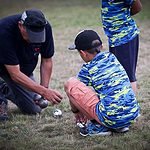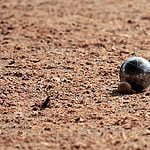You may think that pumping up a Spikeball is just a simple task, but the truth is, the right inflation level can make all the difference in your gameplay.
Imagine the impact of having precise air pressure on your control and responsiveness during intense matches. However, determining the ideal inflation level involves more than just guesswork.
So, how do you find that perfect balance for your Spikeball? Let's explore the intricacies of Spikeball inflation together.
Factors Affecting Spikeball Inflation
Factors that influence the inflation of a Spikeball include environmental conditions, playing surface type, player preferences, individual playing styles, and the ball's elasticity and material composition. Temperature variations play a critical role in determining the ideal air pressure of the Spikeball.
For instance, in colder temperatures, the air inside the ball contracts, leading to a decrease in pressure, while in warmer conditions, the air expands, causing an increase in pressure. Surface differences also impact inflation levels; a softer surface may require a slightly higher inflation to maintain the best bounce and playability compared to a harder surface.
Player preferences and material elasticity are equally important. Some players may prefer a softer feel to the ball, requiring lower inflation levels, while others might opt for a firmer touch, necessitating higher pressure. The elasticity of the material influences how the Spikeball responds to varying inflation levels, affecting its bounce, speed, and overall performance during gameplay.
Optimal Spikeball Air Pressure
To optimize your Spikeball gameplay experience, maintaining an air pressure between 6-8 PSI is essential for achieving the desired balance of responsiveness, control, and playability. Here are some key points to take into account when aiming for the ideal air pressure:
- Customized Pressure: Adjusting the air pressure within the recommended range allows you to personalize the feel of the ball to suit your preferences and playing style. Lower pressures offer more bounce, while higher pressures provide greater control and accuracy.
- Inflation Techniques: Utilizing proper inflation techniques, such as using a reliable pressure gauge and making small adjustments as needed, guarantees that the Spikeball is inflated consistently and accurately. This attention to detail will help maintain the desired performance characteristics of the ball.
- Enhanced Gameplay: Keeping the Spikeball within the 6-8 PSI range enhances gameplay by ensuring a predictable bounce, improved handling, and overall better performance on the playing surface. Consistent air pressure contributes to a more enjoyable and competitive gaming experience.
Impact of Overinflation
Overinflating your Spikeball can result in a higher risk of bursting and a significant reduction in ball control. Excessive air pressure compromises the ball's ability to respond to your moves effectively, impacting your gameplay negatively.
To maintain vital performance and safety, it's essential to adhere to the recommended pressure range of 6-8 PSI.
Risk of Bursting
Inflating a Spikeball beyond the recommended pressure levels poses a significant risk of bursting, which can result in injury to players and damage to equipment. To understand the dangers associated with overinflation, consider the following points:
- Bursting Risks: Overinflating the Spikeball increases the internal pressure beyond its design limits, making it susceptible to bursting during gameplay.
- Structural Integrity: Excessive air pressure compromises the structural integrity of the ball, leading to potential failure and bursting incidents.
- Injury Prevention: Following recommended inflation guidelines is essential for preventing bursting incidents, as it guarantees the safety of players and the longevity of the equipment.
Maintaining proper inflation levels is vital to mitigate the risks of bursting and guarantee a safe Spikeball experience for everyone involved.
Reduced Ball Control
Exceeding the recommended pressure levels when inflating a Spikeball can result in diminished ball control, impacting gameplay dynamics dramatically. Overinflation leads to increased rigidity and bounce, causing the ball to be less responsive to player movements. This reduced responsiveness makes it harder to predict the ball's trajectory during gameplay, affecting your ability to execute precise shots and passes effectively.
As a player, you may find it challenging to maintain accuracy and control over the ball when it's overinflated. To improve your skills and gameplay strategies, it's essential to adhere to the recommended inflation level. By doing so, you guarantee optimum ball control, enhancing your overall experience and performance on the Spikeball court.
Consequences of Underinflation
Underinflating your Spikeball can lead to a noticeable decrease in responsiveness during matches. The ball's bounce and maneuverability on the net are greatly impacted by insufficient air pressure.
Deformation and a lack of shape retention are common issues with underinflated Spikeballs, affecting both performance and safety.
Impact of Underinflation
With inadequate inflation, the responsiveness and control of the Spikeball ball are greatly compromised, impacting gameplay dynamics and player performance. Underinflation in Spikeball can have significant consequences:
- Decreased Accuracy: An underinflated ball makes it challenging to execute precise shots and movements, affecting player accuracy.
- Loss of Bounce: Reduced air pressure leads to a lack of bounce, altering the typical gameplay dynamics and making rallies less dynamic.
- Shape Integrity: Underinflated Spikeball balls are more susceptible to deformation, hindering their ability to maintain a consistent shape during intense play.
Maintaining essential inflation levels is vital to ensure a satisfying Spikeball experience, emphasizing the importance of avoiding underinflation for both performance and enjoyment.
Performance and Safety
Maintaining best inflation levels in your Spikeball is important for ensuring peak performance and player safety. Underinflated Spikeball can impact player performance by decreasing responsiveness, making it challenging to control and maneuver during gameplay. The reduced air pressure compromises the ball's bounce and playability, ultimately affecting the overall gaming experience.
Additionally, underinflation can lead to erratic ball behavior, which disrupts the predictability and consistency of shots, altering game dynamics. Safety risks such as finger jamming and an increased likelihood of injuries are heightened with an underinflated Spikeball.
To mitigate these issues and optimize player performance while preventing injuries, it's vital to maintain the recommended inflation range of 6-8 PSI for your Spikeball.
Measuring Spikeball Air Pressure
To accurately measure the air pressure of your Spikeball, utilize a pressure gauge or perform a manual hand test for best gameplay performance. When checking the air pressure of your Spikeball, consider the following measuring techniques and inflation guidelines:
- Pressure Gauge: Use a pressure gauge specifically designed for measuring low pressures like those in Spikeballs. Simply attach the gauge to the inflation valve, and it will provide an accurate reading of the air pressure inside the ball.
- Manual Hand Test: Squeeze the Spikeball with your hands to assess its firmness. The ball should have a slight give without being too soft or too rigid. This method gives you a rough estimate of the air pressure level and can help you determine if further adjustments are needed.
- Visual Inspection: Check the overall shape and firmness of the Spikeball. A properly inflated ball should be round and taut. If you notice any deformities or excessive sagging, it may indicate improper inflation levels.
Regularly using these measuring techniques will make sure that your Spikeball remains within the recommended air pressure range for best gameplay performance.
Achieving the Perfect Inflation
Achieve the perfect inflation level for your Spikeball by ensuring the air pressure falls within the recommended range of 6-8 PSI. Proper inflation is essential as it impacts the responsiveness, control, and playability during matches. To customize your Spikeball experience, experiment with pressure levels within the suggested range, adjusting based on personal preferences and playing style. By fine-tuning inflation based on environmental conditions and playing surface type, you can gain gameplay advantages and enhance overall performance. Utilize the table below to explore different inflation techniques and customization options:
| Inflation Techniques | Customization Options |
|---|---|
| Experiment with pressure levels | Adjust based on personal preferences |
| Maintain within 6-8 PSI range | Enhance gameplay based on playing style |
| Consider environmental factors | Optimize for different playing surfaces |
Maintaining Ideal Air Pressure
For best gameplay performance with your Spikeball, make sure the air pressure remains within the recommended range of 6-8 PSI. To maintain ideal air pressure, follow these key steps:
- Pressure Regulation: Regularly check the air pressure using a reliable pressure gauge to make certain it falls within the specified range. Make adjustments as needed to keep the Spikeball properly inflated.
- Inflation Techniques: When inflating the Spikeball, use a hand pump or an electric pump designed for sports balls. Avoid using high-pressure pumps that can easily overinflate the ball.
- Monitor and Adjust: Perform a manual squeeze test by pressing on the ball to gauge its firmness. If the Spikeball feels too soft or too hard, release or add air accordingly until it reaches the best pressure level.
Enhancing Spikeball Gameplay
Maintain peak performance in your Spikeball matches by strategically adjusting the inflation levels to enhance gameplay dynamics and responsiveness. Finding the sweet spot between 6-8 PSI can greatly impact your game, providing a balance of responsiveness and control. Experimenting within this range allows you to tailor the inflation to suit your playing style, optimizing maneuverability and playability during matches. By preserving the recommended inflation levels, you guarantee not only your safety but also enhance overall game fluidity and performance. Consider the following inflation techniques and player strategies to elevate your Spikeball experience:
| Inflation Techniques | Player Strategies | Air Pressure |
|---|---|---|
| Experiment within the recommended range | Adapt to opponents' gameplay | Best at 6-8 PSI |
| Find the ideal inflation level for your style | Utilize quick reflexes for better control | Balances responsiveness and control |
| Tailor inflation to preferences and environment | Work on communication and teamwork | Enhances maneuverability and playability |
Conclusion
Now that you understand the importance of maintaining the correct inflation level for Spikeball, you're ready to elevate your game to new heights. By carefully monitoring air pressure, you can guarantee peak performance, control, and safety on the court.
Remember, the key to success lies in finding the perfect balance between responsiveness and playability. So, grab your pump, fine-tune your ball, and get ready to dominate the Spikeball arena like never before.
The thrill of victory awaits.





